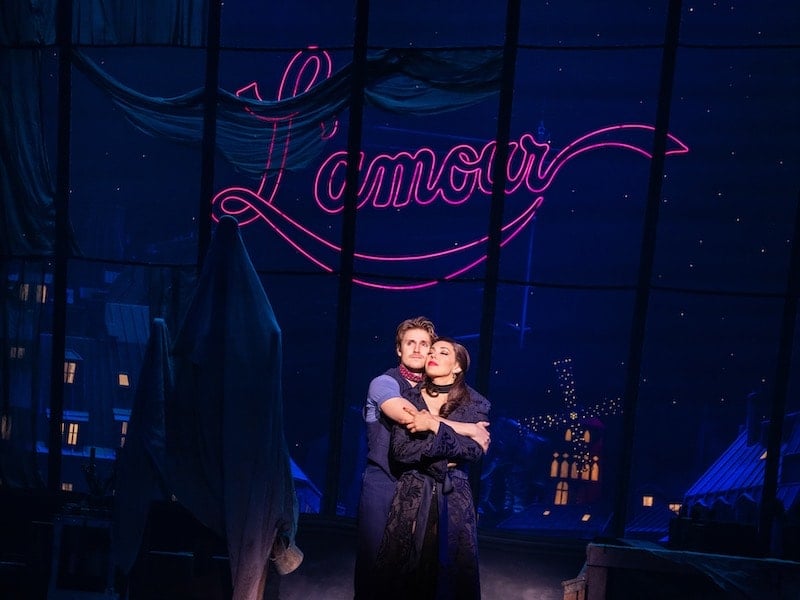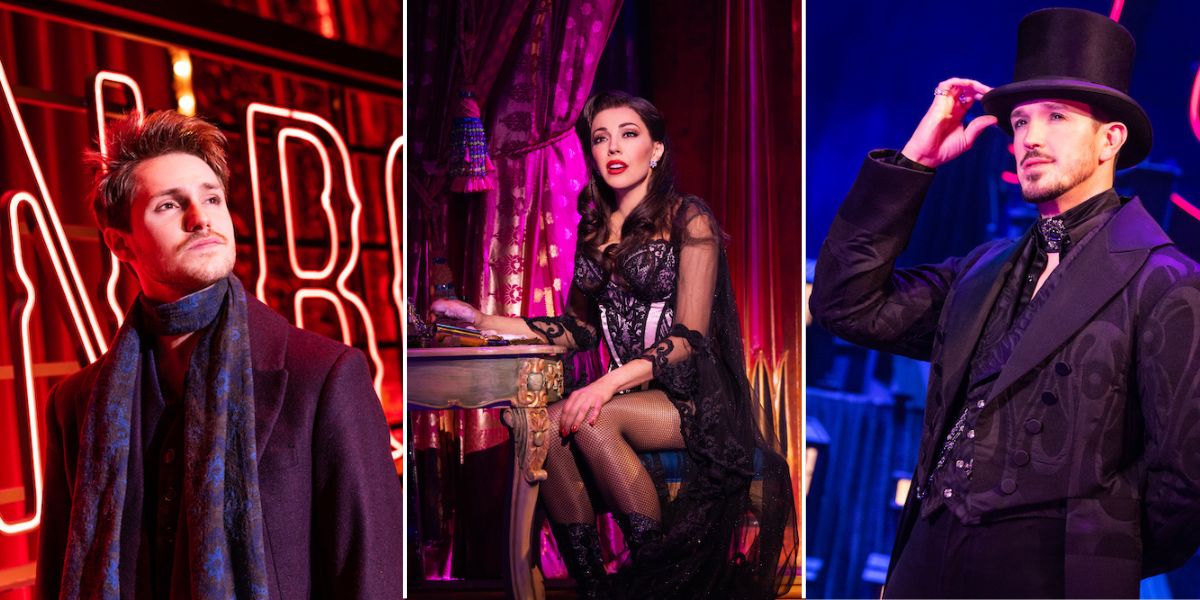Moulin Rouge! The Musical is a valentine on steroids to the love song, and, amid all the glittery, sensuous bump-and-grind, it’s also a love song to the pop love song itself. Clad in corsets, fishnet stockings, top hats, and tails, the Tony Award–winning cast seduces anyone within spitting distance of the Kennedy Center Opera House, heating up what’s already been called the planet’s hottest summer on record.
Based on the 2001 Baz Luhrmann film of the same name, the musical — like the movie — pays homage to the bohemians of French late 19th- and early 20th-century society, reimagining the Parisian nightclub where rich male patrons ogled French cancan dancers kicking up their legs and raising their flounced skirts. But this Moulin Rouge has a decidedly 20th- and 21st-century soundtrack, accompanying a love story as old as time. French painter Toulouse-Lautrec, of course, captured the sexy, seedy, glorious color of it all while exposing the divisions of class and gender in France. Movie director Luhrmann focused his lens on the richly saturated colors, kaleidoscopic shots, and expressive faces of key players — Jim Broadbent, John Leguizamo, Nicole Kidman, and Ewan MacGregor — and the working poor.

At the Opera House, the national touring production tempts with scenic designer Derek McLane’s tricked-out show curtain: a scrim of successive oversized hearts abutted by the iconic Montmartre windmill and a circus elephant framing the stage. Burlesque acts and sinewy dances behind a scrim warm up the arriving crowd. Then the spectacle directed by Alex Timbers bursts with a fusion song and dance number of high-kicking cancan girls and barely clad strip teasers. Emcee and club owner Harold Zidler (pliant-faced Austin Durant) welcomes the balcony-dwelling “chickens” and downstairs aristocracy to the theater. While not as sinister as the emcee from Cabaret, his lasciviousness sets the tone for an off-kilter evening in the seedy club underworld. The musical’s banger, “Lady Marmalade” (which Patti LaBelle made famous in another millennium) revs everyone up. Meanwhile, Justin Townsend’s saturated red lights sweep the audience like a plane on a rescue mission. The dancers hold nothing back mimicking Zidler’s nod to this place where, he claims, both dreams and filthy desires come true. And what could they hold back in Catherine Zuber’s sexy Fredrick’s of Hollywood–meets–Folies Bergère costumes featuring skin-tight bustiers, black garters and stockings, and a chorus of male patrons in top hats, black tie, and tails?
As the La bohème–like plot, penned by John Logan, unfolds, Zidler steps aside, and ingenue — or perhaps “mangenue” — Christian (fresh-faced John Cardoza) enters, just off the boat from Lima, Ohio, ready to experience the wiles and wonders of the Montmartre neighborhood of Paris. His mission: to become an artist of the bohemian revolution and find what he lacks: love. Or L’amour, as the backdrop screams in red calligraphy. Meanwhile, the tallest incarnation of Toulouse-Lautrec I’ve seen (Denzel Tsopnang, understudying Nick Rashad Burroughs) and his friend Argentine tangoist Santiago (feisty Gabe Martinez) are set on writing love songs for their groundbreaking show. Yes, folks, this is also a backstage musical. Among the songs they fiddle with are such far-from-turn-of-the-19th-century hits as “The Sound of Music.” Lo and behold, Christian also writes love songs: including the Elton John hit “Your Song.”
Anticipation builds to the entrance of Satine, the most desirable performer/courtesan at the nightclub. Satine doesn’t disappoint as she is lowered from the rafters, swathed in form-fitting black lingerie and fishnet stockings. Unlike Kidman in the film, Yvette Gonzalez-Nacer is no gossamer girl. Her Satine is hearty and sturdy and belts like the dickens; she knows who she is and what she wants, and even in a case of mistaken identity, she wants naïve, clean-cut Christian. But no love story is interesting without a competitor villain to triangulate the challenge. Here that challenge to the lovers is The Duke of Monroth (Andrew Brewer), a monied aristocrat whom Zidler courts to fund his financially strapped club. As powerfully pumped up as Satine appears, apparently — though not believably — she suffers from consumption, a death sentence in 1899. And, of course, like any good show-biz trooper, the show must go on, even as she coughs into her handkerchief.

But, really, no one comes into Moulin Rouge! for a scintillating plot and high drama. This jukebox musical is scored with 70 (!) remixed and mashed-up songs drawn from composer/songwriters as varied as Bizet, Cab Calloway, Gilbert and Sullivan, Edith Piaf, Bob Dylan, Berry Gordy, Mick Jagger, Keith Richards, Elton John, Lady Gaga, Sia, and the list goes on and on. Show stats note that the songs were written by 160 composers spanning 160 years of Western popular music. (Justin Levine is credited with music supervision, co-orchestration, arrangements, and additional lyrics.)
From ballads to love songs to full-on bangers, the songs pump up the crowd, then bring them down, before another crescendo of recognizable pop standards rises again. The 12-piece orchestra — two pianos, drums, reeds, trumpet, guitar, bass, violin/viola, and cello — is supplemented with electronic synthesizers for the appropriate discothèque feel. And, audiences, beware, some may find the amplified sound system l o u d. Accompanying this pastiche of songs, choreographer Sonya Tayeh — who made a name for herself on television competition dance shows and music videos, has also created works for Broadway, American Ballet Theatre, and the Martha Graham Dance Company — appropriately leans into the bump-and-grind as much as the step-ball-change. She challenges the excellent cast of dancers with nose-grazing kicks, sensuous pas de deux, an old-school rough-and-tumble male-dominant Apache tango duet, and, of course, the confetti-filled spectacle that is “Lady Marmalade.”

This 2019 musical, which took 10 Tonys (in a slim pandemic year), including Best Musical, Best Direction, and Best Choreography, thrives on energetic pop culture favorites that fill the theater like an overstuffed turkey with earworms, lyrical snippets, and an occasional verse or two, but rarely a fully played and sung song. If there was ever a jukebox musical perfect for the TikTok generation, this is it. With some musical clips clocking in at barely more than a minute — enough to nod in recognition of a familiar tune or lyric, but not enough to place the decade or cover artist, let alone the composer or even name of the song — sometimes, at least for my memory, it feels like an episode of Name That Tune.
No matter, the cast is on to the next Hit Parade/Top 40 hit momentarily. Moulin Rouge! The Musical earns its exclamation mark with its intentionally over-the-top Gesamtkunstwerk (total work of art) — with direction, choreography, musical pacing and direction, costumes, sets, dance, and performance that together are unabashedly extravagant. While wholesome Christian is introduced to the bohemian slogan “Truth. Beauty. Freedom. Love” as a rebellious lifestyle, love is his and this show’s focus. But it isn’t deep love, it’s Hollywood-idealized romantic love. The musical is a flashy, glitter-filled valentine to an idealized version of male-female love, a certain crowd-pleaser filled with eye and ear candy that will get hearts pumping with both sweet and tangy marmalade.
Running Time: Two hours and 40 minutes, including one 20-minute intermission.
Moulin Rouge! The Musical plays through September 24, 2023, in the Opera House Theater at the Kennedy Center, 2700 F St NW, Washington, DC. Tickets ($45–$199) are available at the box office, online, or by calling (202) 467-4600 or (800) 444-1324.
The program for Moulin Rouge! The Musical is online here.
COVID Safety: Masks are optional in all Kennedy Center spaces for visitors and staff. If you prefer to wear a mask, you are welcome to do so. See Kennedy Center’s complete COVID Safety Plan here.




